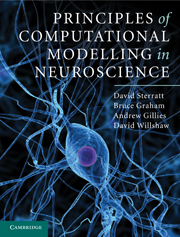Book contents
- Frontmatter
- Contents
- List of abbreviations
- Preface
- Acknowledgements
- Chapter 1 Introduction
- Chapter 2 The basis of electrical activity in the neuron
- Chapter 3 The Hodgkin–Huxley model of the action potential
- Chapter 4 Compartmental models
- Chapter 5 Models of active ion channels
- Chapter 6 Intracellular mechanisms
- Chapter 7 The synapse
- Chapter 8 Simplified models of neurons
- Chapter 9 Networks of neurons
- Chapter 10 The development of the nervous system
- Chapter 11 Farewell
- Appendix A Resources
- Appendix B Mathematical methods
- References
- Index
Chapter 11 - Farewell
- Frontmatter
- Contents
- List of abbreviations
- Preface
- Acknowledgements
- Chapter 1 Introduction
- Chapter 2 The basis of electrical activity in the neuron
- Chapter 3 The Hodgkin–Huxley model of the action potential
- Chapter 4 Compartmental models
- Chapter 5 Models of active ion channels
- Chapter 6 Intracellular mechanisms
- Chapter 7 The synapse
- Chapter 8 Simplified models of neurons
- Chapter 9 Networks of neurons
- Chapter 10 The development of the nervous system
- Chapter 11 Farewell
- Appendix A Resources
- Appendix B Mathematical methods
- References
- Index
Summary
This book has been about the principles of computational neuroscience as they stand at the time of writing. In some cases we have placed the modelling work that we described in its historical context when we felt this would be useful and interesting. We now make some brief comments about where the field of computational neuroscience came from and where it might be going.
The development of computational modelling in neuroscience
The field of computational modelling in neuroscience has been in existence for almost 100 years. During that time it has gone through several stages of development. From the 1930s, researchers in the field of mathematical biophysics conceived of mathematical and physical models of biophysical phenomena. In the more neural applications, there was work on how networks of nerve cells could store and retrieve information through the adaptive tuning of the thresholds of selected nerve cells (Shimbel, 1950), on linking psychophysical judgements with the underlying neural mechanisms (Landahl, 1939) and mathematical accounts of how nerve cells could act as logical elements and what the computational capabilities of a network of such elements were (McCulloch and Pitts, 1943). From the 1950s onwards there was interest in treating the brain as a uniform medium and calculating its modes of behaviour, such as the conditions under which it would support the propagation of waves of activity across it (Beurle, 1956). Much of this work laid the foundation for the field of artificial neural networks in the 1950s and 1960s.
Information
- Type
- Chapter
- Information
- Principles of Computational Modelling in Neuroscience , pp. 314 - 318Publisher: Cambridge University PressPrint publication year: 2011
